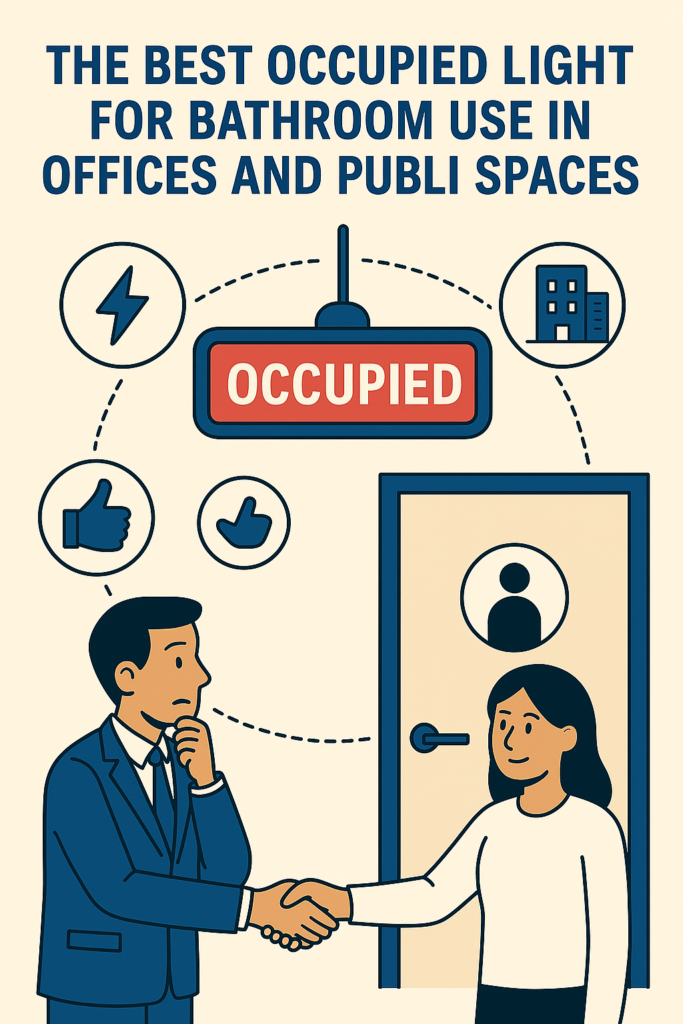
If you’ve ever jiggled a locked door handle only to be met with an awkward “Someone’s in here!”—then you already understand why an occupied light for bathroom spaces is more than just a fancy gadget.
It’s a small, smart fix to a problem we’ve all faced.
Especially in shared environments like offices, restaurants, coworking spaces, or even schools—knowing whether a bathroom is in use without knocking can save time, embarrassment, and frustration.
Let me walk you through a quick story.
Last year, I started working out of a co-working space in Bangalore.
There were only two single-use bathrooms on the entire floor, and they didn’t have any kind of indicator.
Cue the constant door-rattling, confused waiting, and that one guy who always shouted “Occupied?” every single time.
It wasn’t just annoying—it actually broke concentration during work hours.
Eventually, the management installed a light-up indicator outside both bathrooms, and boom—problem solved.
Everyone suddenly respected boundaries, stopped guessing, and things just flowed better. Literally.
It’s a simple piece of tech, but it changes everything.
Occupied light for bathroom installations are now becoming the go-to fix for privacy and functionality in public restrooms.
Let’s dig into what makes a good one, and how to pick the best.
Why Bathroom Occupancy Indicators Matter More Than You Think
You might think it’s just a light.
But the right light sends the right message—clearly, instantly, and without disruption.
Whether it’s a red/green LED system or a smart sensor-based setup, it eliminates the need for awkward encounters.
In an office setting, it improves workflow.
No more breaks in meetings just to check if the bathroom is free.
In a restaurant, it reduces customer complaints.
No tapping toes or long lines because someone didn’t realize the stall was in use.
In schools or libraries, it helps maintain peace and decorum.
Plus, there’s something about automation that gives a space a more polished, modern feel.
Even small things like this affect your brand image.
Types of Occupied Lights for Bathrooms (And Which One to Choose)
1. Mechanical Lock-Linked Indicator Lights
These are the most traditional ones.
When the lock turns, a signal is sent to the light outside the door.
It’s simple and effective.
There’s no guesswork—if the lock is turned, the outside light shows red.
Once unlocked, it flips back to green.
These are perfect for high-traffic office restrooms or public libraries.
They don’t rely on motion sensors or batteries—just a solid mechanical connection.
2. Motion Sensor-Based Bathroom Indicators
These work on movement inside the bathroom.
Once someone enters, the sensor detects occupancy and lights up the “In Use” sign.
These are more common in tech-forward buildings or smart homes.
But be cautious—sometimes, if the user is still or the sensor isn’t positioned correctly, the light might falsely indicate that it’s free.
Not ideal for tight, timed environments like restaurants or airport lounges.
3. Smart Integrated Systems with Timers and Apps
These are the luxury version.
Fully integrated systems that connect with locks, lighting, and even mobile apps.
Great for large co-working spaces or premium office complexes.
They come with installation costs and maintenance, though, so unless you’re managing a high-end facility, these may be overkill.
Real-World Experiences: What Actually Works?
I interviewed a few managers from different office setups to get the ground truth.
Rachit, who manages a startup space in Gurgaon, said:
“We had people leaving post-it notes on the door saying ‘Occupied’—it was ridiculous. We installed a mechanical lock-based indicator two months ago, and now everyone’s happy. It’s quiet, clear, and no maintenance headache.”
Leah, who runs a yoga studio in Goa, prefers motion sensors:
“We needed a touchless solution because of hygiene concerns. Motion sensors felt like the cleanest, simplest option.”
Both work—depending on your setup, traffic, and privacy needs.
What you choose should align with how your space is used.
If people are rushing in and out, go for reliability over tech bells and whistles.
Installation Tips: Don’t Overthink It
You don’t need an electrician with a PhD to install one.
Most mechanical systems can be installed in under 15 minutes.
Sensor-based models might need a bit more setup—especially if they require calibration.
Here are a few tips:
- Position the light clearly at eye level outside the door.
- Choose neutral, easily understood indicators like red/green or occupied/vacant.
- Avoid overcomplicating—a simple system will get used. A complex one might get ignored.
- Check your building codes—especially in commercial spaces.
Bonus Perk: Accessibility and Inclusivity
An often overlooked benefit?
Occupied lights can help people with anxiety, neurodivergence, or disabilities.
For people who feel uncomfortable knocking or interrupting others, a visual cue is a huge help.
It makes shared environments feel more respectful and safe.
In fact, many ADA-compliant facilities are beginning to include visual indicators as part of universal design strategies.
It’s not just a convenience—it’s a way to make your space more inclusive.
What to Avoid When Choosing a Bathroom Occupied Light
- Battery-Only Systems: You’ll forget to change the batteries, and the whole point of the light goes out the window.
- Complex App-Based Models: Unless you’re a hotel chain or Google’s campus, it’s probably not worth the cost and complexity.
- No Indicator at All: This might sound obvious, but so many public restrooms still rely on manual knocking or trial and error.
Final Thoughts
Choosing the best occupied light for bathroom spaces isn’t about picking the fanciest option.
It’s about solving a simple problem with a simple solution.
Privacy.
Clarity.
Ease.
Whether it’s for an office, studio, school, or small café—this one upgrade improves the experience instantly.
And in a world where comfort and convenience go a long way, it’s these little things that make a big impact.
Needless to say, I haven’t had to shout “Someone’s in here!” in months—and neither should you.
Read More: What is monkeytype?